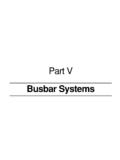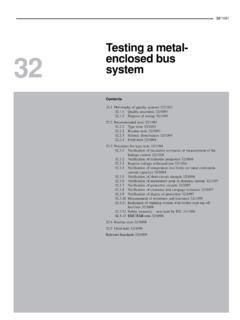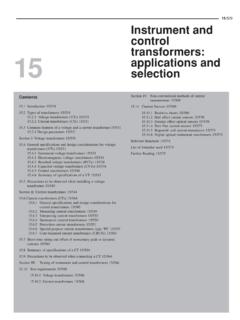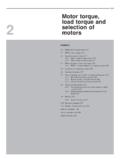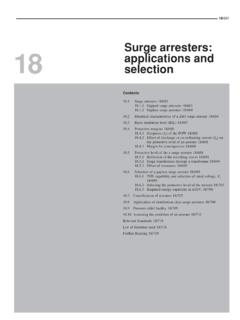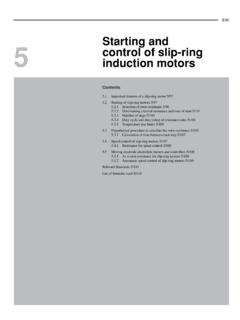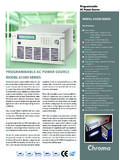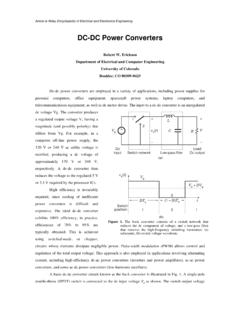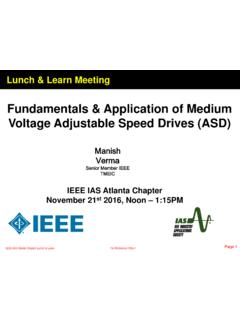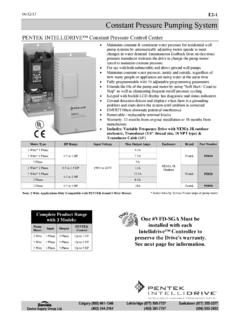Transcription of Electrical Power Engineering Reference & …
1 Electrical Power Engineering Reference &. Applications Handbook Electrical Power Engineering Reference &. Applications Handbook K. C. Agrawal (Engg.) Electrical , Senior Member IEEE, USA, Industrialist and Consultant Copyright Page Copyright 2007 by Agrawal Dedicated to my parents with A Guilt of Neglect Had I cared them a little more, Had I loved them a little more! My loving parents have gone, And so goes my heart! The memories would stay and So will the Guilt. K. C. Agrawal Contents Preface to this edition xi 5 Starting and control of slip-ring Preface to the first edition xv induction motors 95. Acknowledgements xvii Important features of a slip-ring motor Starting of Technical support xix slip-ring motors Hypothetical procedure to calculate Introduction xxiii the rotor resistance Speed control of slip-ring motors Moving electrode electrolyte starters and controllers Part I Electric motors, drives and energy saving 1 376 6 Static drives and energy saving 111. Speed control in squirrel cage motors Speed control 1 Theory, performance and constructional through solid-state technology V/f control (speed features of induction motors and control at constant torque) Phasor (vector) control.
2 Energy saving 1 Use of phasor control for flux braking Control and Introduction Brief theory of operation of a polyphase feedback devices Evolution of solid-state technology motor Motor output and torque Motor ratings and Conduction and commutation Circuit configurations frame sizes Preferred ratings at different voltages of semiconductor devices Smoothing of ripples in Influence of service conditions on motor performance the link Providing a constant voltage source No-load performance Effect loading on motor Providing a constant current source Generation of performance Effect of steel laminations on core harmonics, over-voltages and voltage surges in a static losses Circle diagram Types of induction motors device switching circuit and to mitigate their effects . Mounting of motors Enclosures Weatherproof PWM inverter drives causing shaft currents Energy (WP) motors Degree of protection Cooling systems conservation using static drives Application of static in large motors Single phase motors Theory of controllers Speed variation through variable-speed operation Energy coservation, energy auditing and fluid couplings Static drive versus fluid coupling.
3 Energy efficient motors (EEM) drives Retrofitting of EE motors and drives 2 Motor torque, load torque and selection 7 Special-purpose motors and induction of motors 41 generators 185. Motor speed-torque curve NEMA rotor designs Textile motors Crane motors Determining the size Special designs of rotors Effect of starting current on of motor Sugar centrifuge motors Motors for deep- torque Load torque or opposing torque Selection of well pumps Motors for agricultural application . motors Time of start-up and its effect on motor Surface-cooled motors Torque motors or actuator performance Thermal withstand time Braking motors Vibration and noise level Service factor . Inching or jogging Number of starts and stops Motors for hazardous locations Specification of motors for Zone 0 locations Specification of motors 3 Duties of induction motors 63 for Zone 1 locations Motors for Zone 2 locations . Duty cycles Continuous duty (CMR) (S1) Periodic Motors for mines, collieries and quarries . duties Factor of inertia (FI) Heating and cooling Intrinsically safe circuits, type Ex.
4 I' Testing and characteristic curves Drawing the thermal curves certifying authorities Additional requirements for Rating of short-time motors Equivalent output of critical installations Motors for thermal Power short time duties Shock loading and use of a flywheel station auxiliaries Selection of a special-purpose motors Induction generators 4 Starting of squirrel cage induction motors 83 8 Efficient transmission of loads 221. Direct on-line starting (DOL) Reduced voltage starting Direct or rigid couplings Flexible couplings . viii Contents Delayed-action couplings Construction and principle switchgear assembly HV switchgear assemblies . of operation Belt drives Checking the suitability of Protection schemes General guidelines during bearings Suitability of rotors for pulley drives installation and maintenance of a switchgear or a controlgear assembly Power circuits and control 9 Winding insulation and maintenance 255 scheme diagrams Insulating materials and their properties Ageing of insulation Practices of insulation systems APPENDIX Painting procedure of switchgear and Procedure for vacuum pressure impregnation controlgear assemblies and treatment of effluent Maintenance of insulation Monitoring the quality of 461.
5 Insulation of MV formed coils and resin-poor windings during manufacturing 14 Testing of a metal-enclosed switchgear assemblies 483. 10 Installation and maintenance of electric Philosophy of quality systems Use of environment motors 267 friendly substances (RoHS) Recommended tests . Installation of bearings and pulleys Important checks LV impulse test Procedure for type tests Procedure at the time of commissioning Maintenance of for routine tests Procedure for field tests . electric motors and their checks Maintenance of Introduction to mechanical impact test, internal arc bearings General problems in electric motors and test and EMC/EMI (electromagnetic compatibility and their remedy Winding temperature measurement at emission) tests An introduction to earthquake site Analysis of insulation failure of an MV motor at Engineering and testing procedure A passing a thermal Power station Reference to tsunami 15 Instrument and control transformers: 11 Philosophy of quality systems and applications and selection 529.
6 Testing of Electrical machines 283 Introduction Types of Transformers Common Philosophy of quality systems Transition to ISO features of a voltage and a current transformer . 9001(2000) Testing of Electrical machines General specifications and design considerations for Procedure for testing Load test No-load test voltage transformers Precautions to be observed Tolerances in test results Certification of motors while installing a voltage transformer Current used in hazardous locations transformers Short-time rating and effect of momentary peak or dynamic currents Summary of 12 Protection of electric motors and specifications of a CT Precautions to be observed selection of components 317 when connecting a CT Test requirements Non- Purpose Unfavourable operating conditions Fault conventional methods of current measurement (sensors conditions Protection Single-device motor and transducers) Rogowski coils protection relays Summary of total motor protection Motor protection by thermistors Monitoring of a 16 Captive (emergency) Power generation motor's actual operating conditions Switchgears for 577.
7 LV motors Selection of main components Fuse-free Introduction DG set Operating parameters Theory system Switchgears for MV motors Microprocessor of operation Guidelines on the selection of a DG set based devices (IEDs) and intelligent starters Types of loads Starting of a DG set Protection of a DG set Parallel operation Procedure of parallel APPENDIX Rule of thumb for everyday use 367 operation Fault levels and grounding of generators . Recommended protection for a synchronizing scheme Load sharing by two or more generators Total Part II Switchgear assemblies and automation through PLCs captive (emergency) Power generation 377 642 APPENDIX Selection of Power cables PVC, paper insulated and XLPE and ampacity tables 617. 13 LV switchgear and controlgear assemblies 379 Part III Voltage surges, over- Application Types of assemblies Conventional voltages, circuit types of switchgear and controlgear assemblies (also interrupters and referred to as switchboards) Compact switchgear assemblies Intelligent switchboards Design grounding practices parameters and service conditions for a switchgear 643 822.
8 Assembly Determining fault level of a system and its duration Energy based discrimination Deciding the 17 Voltage surges causes, effects and ratings of current-carrying equipment, devices and remedies 645. components Designing a bus system Designing a Introduction Temporary over-voltages Voltage Contents ix surge or a transient Transient stability of overhead gradients Determining the leakage current through a lines Causes of voltage surges Definitions Causes human body Measuring the average resistivity of of steep rising surges Effect of steep-fronted TRVs soil Improving the performance of soil . on the terminal equipment (motor as the basis) Determining the ground fault current Designing a Determining the severity of a transient Protection of grounding grid rotating machines from switching surges Theory of surge protection (insulation coordination) LV surge protection and surge protection devices (SPDs) Part IV Power capacitors and reactive Power 18 Surge arresters: applications and controls 823 980.
9 Selection 681. Surge arresters Electrical characteristics of a ZnO 23 Power capacitors: behaviour, switching surge arrester Basic insulation level (BIL) phenomena and improvement of Power Protective margins Protective level of a surge arrester Selection of gapless surge arrester factor 825. Classification of arresters Surge protection of motors SECTION I 827. Pressure relief facility Assessing the condition of an arrester Introduction Application of Power capacitors Effect of low PF Other benefits of an improved Power 19 Circuit interrupters and their factor Behaviour of a Power capacitor in operation . applications 721 Generation of triple harmonics in an inductive circuit Generation of harmonics by a Power electronic Circuit interrupters Theory of circuit interruption circuit Resonance Effective magnitude of harmonic with different switching mediums (theory of voltages and currents When harmonics will appear in deionization) Theory of arc plasma Circuit a system Filter circuits: suppressing harmonics in a breaking under unfavourable operating conditions.
10 Power network Excessive charging currents Circuit interruption in different mediums HV and (switching inrush or making currents) Limiting the LV vacuum contactors Current chopping Virtual inrush currents Capacitor panel design parameters . current chopping Containing the severity of Capacitor rating for an induction motor Location of switching surges Comparison of interrupting devices capacitors Automatic PF correction of a system . Gas insulated switchgears (GIS) Retrofitting of old Switching sequences PF correction relays installations SECTION II 873. 20 Temporary over-voltages and system Electromagnetic compatibility (EMC) . grounding 759 Electromagnetic interferences (EMI). Theory of overvoltages Analysis of ungrounded and grounded systems The necessity of grounding an Electrical system Analysis of a grounded system 24 System voltage regulation and improving Arc suppression coil or ground fault neutralizer Power quality 881. Ground fault factor (GFF) Magnitude of temporary Capacitors for improving system regulation Series over-voltages Insulation coordination Application capacitors Rating of series capacitors Advantages of different types of grounding methods (for MV, HV of series compensation Analysis of a system for and EHV systems) Important parameters for series compensation Reactive Power management.
